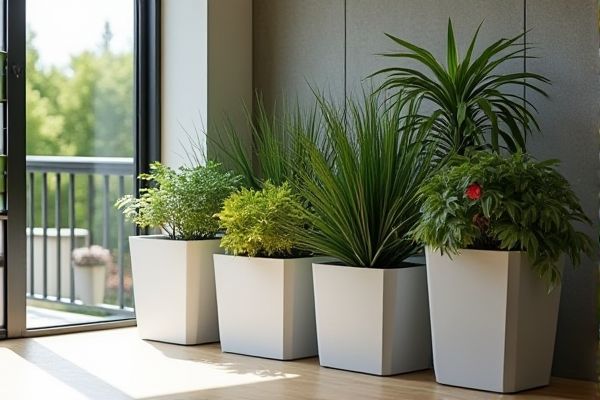
Built-in planters blend seamlessly with your outdoor architecture, offering a sturdy, space-saving option that enhances landscape design, while freestanding planters provide versatility, mobility, and the ability to change your garden layout effortlessly. Discover which planter type suits your gardening needs best by exploring the detailed comparison in the rest of this article.
Table of Comparison
| Feature | Built-in Planter | Freestanding Planter |
|---|---|---|
| Installation | Permanent, integrated into structure | Portable, no installation required |
| Space Usage | Utilizes existing structure space efficiently | Flexible placement, requires floor space |
| Durability | Highly durable, often made of masonry or concrete | Varies; materials include plastic, metal, wood |
| Design Flexibility | Limited once installed | High, easy to change or move |
| Maintenance | Requires access within structure for upkeep | Easy to access and maintain |
| Cost | Higher initial cost due to construction | More affordable, wide price range |
| Applications | Ideal for landscaping, walls, terraces | Best for patios, balconies, flexible gardening |
Introduction to Built-In vs Freestanding Planters
Built-in planters are integrated directly into architectural structures, providing a seamless and permanent gardening solution ideal for patios, decks, or retaining walls. Freestanding planters offer flexibility and mobility, allowing you to easily rearrange plants to suit changing aesthetics or lighting conditions. Choosing between these planters depends on your space, design goals, and whether you prioritize permanence or versatility in your garden setup.
Design Flexibility and Aesthetic Appeal
Built-in planters offer seamless integration with architectural elements, providing a cohesive and tailored aesthetic that complements structural design, while freestanding planters deliver greater design flexibility with the ability to reposition, mix styles, and adapt to changing spaces. Freestanding planters come in a variety of materials and shapes, allowing for personalized statements and seasonal updates, whereas built-in planters emphasize permanence and a streamlined look. Choosing between the two depends on whether the priority lies in dynamic decor versatility or enduring, integrated design harmony.
Space Utilization and Placement Options
Built-in planters maximize space utilization by integrating seamlessly into existing structures such as walls or balconies, making them ideal for compact areas where every inch counts. Freestanding planters offer versatile placement options, allowing you to easily move or rearrange them to suit changing design preferences or seasonal needs. Your choice depends on whether you prioritize permanent, space-saving solutions or flexible, adaptable gardening arrangements.
Installation Process and Requirements
Built-in planters require professional installation with structural support, proper waterproofing, and integration into existing architecture, often involving more time and higher costs. Freestanding planters offer easy setup with minimal requirements, allowing flexibility in placement and no permanent alterations to your space. Choosing between them depends on your installation preferences and the intended longevity of your garden design.
Material and Durability Comparison
Built-in planters are often constructed from durable materials like concrete, brick, or stone, providing long-lasting stability and resistance to harsh weather conditions. Freestanding planters typically use materials such as plastic, metal, or wood, balancing portability with varying levels of durability depending on treatment and quality. Choosing between the two depends on your preference for permanence and material resilience in your garden or outdoor space.
Maintenance Needs and Accessibility
Built-in planters typically require less frequent maintenance due to their integration with existing structures, offering easier access for watering and pruning through fixed positioning. Freestanding planters provide flexibility in placement but often demand more attention to drainage and mobility, which can complicate regular upkeep. Your choice depends on balancing convenience with the ease of reaching plants for consistent care.
Mobility and Adaptability
Freestanding planters offer superior mobility, allowing you to easily rearrange your garden or move plants indoors during harsh weather, enhancing adaptability to changing environments. Built-in planters are typically fixed structures, limiting their relocation but providing stable, integrated gardening solutions ideal for permanent landscape designs. Choosing between them depends on your need for flexible plant placement versus a durable, immovable garden feature.
Cost Analysis and Budget Considerations
Built-in planters typically involve higher upfront costs due to construction and integration expenses, making them a long-term investment in your landscape design. Freestanding planters are generally more budget-friendly, offering flexibility and lower initial outlay, ideal for temporary or movable gardening solutions. Your choice should balance initial cost with durability and design goals to optimize overall budget efficiency.
Environmental Impact and Drainage Effectiveness
Built-in planters typically offer better environmental benefits by using sustainable materials and reducing the need for additional containers, which minimizes waste. Their integrated drainage systems ensure more effective water management, preventing overwatering and soil erosion. Freestanding planters, while versatile, often require synthetic liners or pots that can contribute to environmental waste and may have less efficient drainage, leading to potential root rot or waterlogging issues.
Choosing the Right Planter for Your Space
Built-in planters offer a seamless, integrated look that maximizes space efficiency, especially in small patios, balconies, or indoor areas where a permanent fixture is desired. Freestanding planters provide greater flexibility, allowing easy relocation and design versatility, ideal for dynamic outdoor spaces or seasonal plant arrangements. Selecting the right planter depends on space constraints, desired aesthetics, and whether permanence or mobility is a priority for your garden layout.
 homyna.com
homyna.com